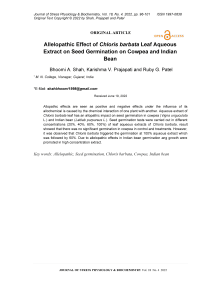Allelopathic effect of chloris barbata leaf aqueous extract on seed germination on cowpea and Indian bean
Автор: Shah Bhoomi A., Prajapati Karishma V., Patel Ruby G.
Журнал: Журнал стресс-физиологии и биохимии @jspb
Статья в выпуске: 4 т.18, 2022 года.
Бесплатный доступ
Allopathic effects are seen as positive and negative effects under the influence of its allochemical is caused by the chemical interaction of one plant with another. Aqueous extract of Chloris barbata leaf has an allopathic impact on seed germination in cowpea ( Vigna unguculata L.) and Indian bean ( Lablab purpureus L. ). Seed germination tests were carried out in different concentrations (20%, 40%, 60%, 100%) of leaf aqueous extracts of Chloris barbata , result showed that there was no significant germination in cowpea in control and treatments. However, it was observed that Chloris barbata triggered the germination at 100% aqueous extract which was followed by 60%. Due to allelopathic effects in Indian bean germination ang growth were promoted in high concentration extract.
Allelopathic, seed germination, chloris barbata, cowpea, indian bean
Короткий адрес: https://sciup.org/143179368
IDR: 143179368
Текст научной статьи Allelopathic effect of chloris barbata leaf aqueous extract on seed germination on cowpea and Indian bean
Allelopathy is a source of plant interaction that occurs when one plant produces a chemical inhibitor that promotes in the growth and development of another (Zeng et al ., 2010). Allelopathy affects plants by releasing allelochemicals, that are secondary metabolites found in all plant tissues such as leaf, stems, flowers, roots, and seeds and can be useful or harmful (Mohsin et al ., 2016). Allelopathy is a process of chemical regulation and control in natural ecological systems, as well as a method by organism convenient environment (Peng et al., 2004). However, the type and concentration of allelochemicals discharged into the environment are determined by the plant's collective effects as well as ambient conditions noted by Cheng & Cheng, (2015). Oudhia, (2000) observed the inhibitory allelopathic effects of Datura root extract on soybean germination. Kalita and Dey, (1998) discovered that shoot extract of Ageratum conyzoides, Borreria hispida, Cynodon dactylon, and Cyperus rotandus showed higher inhibitory activity on rice growth than root extract of Ageratum conyzoides , Borreria hispida, Cynodon dactylon , and Cyperus rotandus . Baloglu et al ., 2012 found that allelopathy is an important factor in determining the distribution and abundance of organisms within populations. Allelopathy is often beneficial to the success of certain imported species, such as spotted knapweed ( Centaurea maculosa, Asteraceae family), nut sedge ( Cyperus rotundus ). Cyperaceae is a genus of plants that belong to the family Cyperaceae. According to Akemo et al., 2000, Legumes can also be used as a source of allelochemicals for weed control. Weeds could be controlled with a mulch made from dead pea plants. The germination and growth of lady's thumb ( Polygonum persicaria L.), smooth pigweed, small flower galinsoga Galinsoga parviflora cav.), and common lamb’s quarters Chenopodium album L.) have been managed by a pea cover crop. Velvet bean ( Mucuna deeringiana Bort. Merr.), jack bean ( Canavalia ensiformis L. DC.), jumbie bean ( Leucaena leucocephala Lam. de Wit), and wild tamarind ( Lysiloma latisiliquum L. Benth.) have been demonstrated to reduce weeds using aqueous leachat.
In recent years, a significant deal of research has been done on plant allelopathy all over the world (Mo, et al ., 2005). The current research was planned to investigate the influence of Chloris barbata allelopathic weed on the growth and seedling of cowpea and Indian bean.
MATERIALS AND METHODS
This experiment was carried out at Visnagar M. N. College. Fresh leaf of Chloris barbata was collected, washed, and crushed into a paste. The leaf was extracted by soaking 50 g of leaf paste in 100 ml distilled water for 24 hours at 25 ± 5°C. The filtrate was made up of 100 ml after it was filtered with filter paper. By diluting the extracts with distilled water, several concentrations of 100 percent, 60 percent, 40 percent, and 20 percent were obtained. The obtained extracts were kept in the laboratory at room temperature. The seeds were soaked overnight in distilled water. The seeds were soaked in 0.1% HgCl 2 solution for 1 minute to sterilize and then washed 3-4 times with distilled water to remove the HgCl 2 residue and dried in folds of ordinary filter papers in each Petri dish containing Whatman no. 1 filter paper was kept at the bottom and there after seeds arranged on the top of the filter paper. The Petri dishes (5 seeds/Petri dish) were covered with glass covering. The treatments were established in a completely with three replicates. The petri dishes were stored at room temperature for seven days in the laboratory, and the germinated seeds were counted to quantify the germination percentage, as well as the length of the shoot.
RESULTS
In this experiment of seed germination, 5 seeds of cowpea and Indian bean were treated with 20%, 40%, 60% and 100% concentration of Chloris barbata leaf aqueous extract and the result was observed after 2, 5 and 7 days in both treatment and control condition.
The data illustrated in Figure 1 also shows that the percentage of seed germination in cowpea (Vigna unguculata L.) was influenced by different concentrations of Chloris barbata leaf aqueous extract. While in control condition and treatment it was observed that no seeds were germinated. Indian bean (Lablab purpureus L.) seeds treated with different concentration of Chloris barbata leaf aqueous extract and observed that 60% and 100% concentration extract was promote seed germination and seedling growth, while at no seed germination was observed in control, 20% and 40% concentration.
Length of shoot (cm)
The result for length of shoot (cm) has affected by allelopathic concentrations Chloris barbata leaf aqueous extract concentrations on cowpea and Indian bean. The Figure 2 showed statistically significant for shoot length (cm) of Indian bean. The results for Indian bean seeds length of shoot (cm) showed significant response towards different allelopathic water extract concentrations. The maximum mean length of shoot cm (4.58) was recorded in 100% concentration(treated) after seven days followed by (3.46) length of shoot (cm) extract concentration 60% after seven days data whereas the minimum length of shoot cm (0.14) in 60% concentration of Chloris barbata leaf aqueous extract after second day result conducted. The Figures 3, 4 and 5 showing the details of the allelopathic effect of Chloris barbata leaf aqueous extract concentrations on indian bean seed germination and seedling growth.
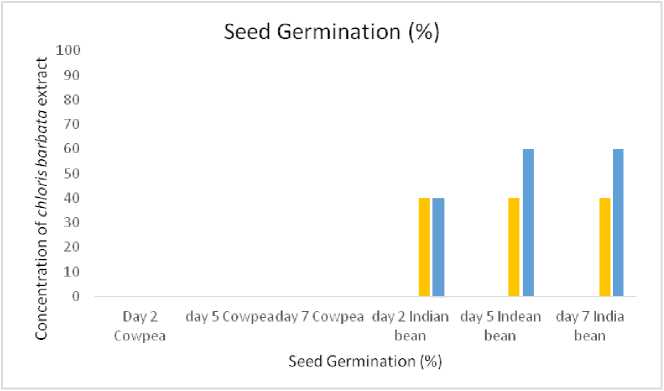
Figure 1: Effect of different concentrations of Chloris barbata leaf aqueous extract on seed germination of Cowpea and Indian bean.
Shoot Length(cm) of Indian Bean
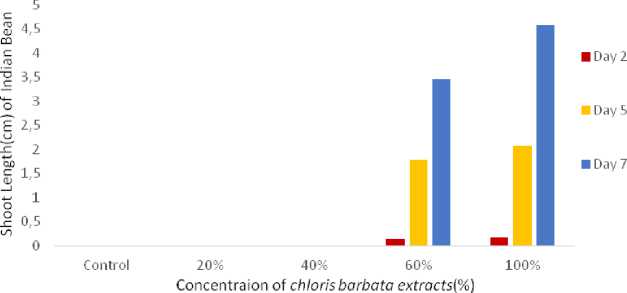
Figure 2: Effect of different concentrations of Chloris barbata leaf aqueous extract on shoot length (cm) of Indian bean
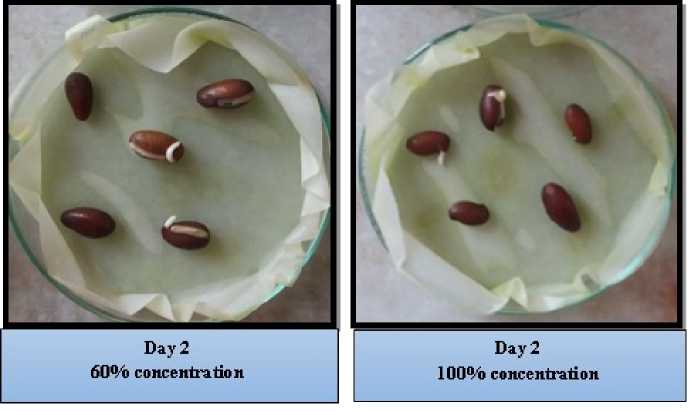
Figure 3: Effect of Chloris barbata 60% & 100% concentrated extracts on Indian bean ( Lablab purpureus L.) on 2nd day

Figure 4: Effect of Chloris barbata 60% & 100% concentrated extracts on Indian bean ( Lablab purpureus L.) on 5th day
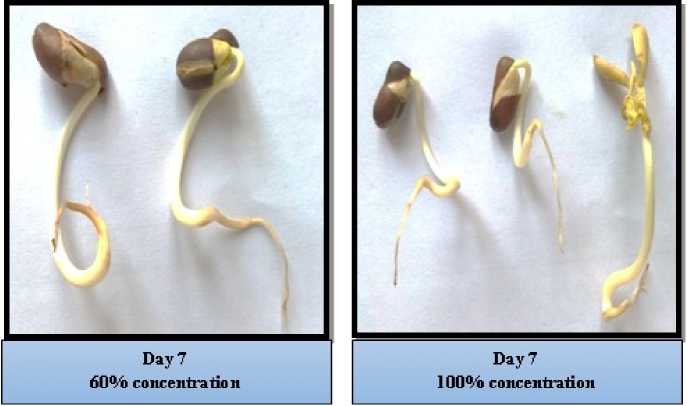
Figure 5: Effect of Chloris barbata 60% & 100% concentrated extracts on Indian bean ( Lablab purpureus L.) on 7th day
DISCUSSION
According to Hussain et al., (2017) the effect of sesame leachate on Chloris barbata shoot length was significantly reduced when compared to control. Kalwar, et al ., (2021) noted that allelopathic effect of fresh Lambs quarter and Sorghum powder water extract concentrations on sunflower were statistically significant for germination and shoot length in higher mean. seed germination 82.44% and 80.72% was recorded in control and application of fresh Chenopodium album L. water extract 30% concentration, followed by 78.57% and 75.150% applications of fresh Chenopodium album L. water extract 30% concentration. The highest mean in shoot length 23.44 cm was recorded in the control, followed by 21.82 cm shoot length using fresh Chenopodium album L. water extract 30% concentration, and 8.820 cm shoot length allelopathic application of fresh Chenopodium album L. water extract concentration 100%, respectively. Kumbhar, (2012) investigated that the allelopathic effect of stem extract of Tephrosia purpuria observe triggering effect on shoot and root lengths as compared to control after 5, 10 and 15 days of the Cajanus cajan . Vitonde, et al ., (2014) revealed that Artemisia and Tridax were also found to decrease Parthenium seed germination by 60%. Previously, Cassia sp . was used in a similar trial against Parthenium . Due to the action of Eucalyptus extracts, Khan, et al., (2008) observed significant reductions in cotton germination percentage, root length, shoot length, fresh weight, and dry weight. Ahmed, (2007), stated that different concentrations of aqueous extracts of Lantana camara leaf showed a significant inhibitory effect on germination, root, and shoot elongation, but the effect was stimulatory at higher concentrations.
CONCLUSION
In can be conclude that Chloris barbata leaf aqueous extract was no significant germination on cowpea. while Indian bean was showed that Chloris barbata extract greatly the germination at 100% aqueous extract which was followed by 60%. Higher concentration extracts demonstrated the strongest allelopathic effect in increasing germination, root, and leaf growth in Indian beans.
CONFLICTS OF INTEREST
The authors declare that they have no potential conflicts of interest.
Список литературы Allelopathic effect of chloris barbata leaf aqueous extract on seed germination on cowpea and Indian bean
- Ahmed R, Belel MU, Sayed MA, Khan A & Hossain K. (2007). Allelopathic effect of Lantana camara on germination and growth behavior of some agricultural crops in Bangaladesh. J. of Forestry research. 18(4): 301-304.
- Akemo MC, Regnier EE, & Bennett MA. (2000). Weed suppression in spring-sown rye (Secale cereale)-pea (Pisum sativum) cover crop mixes. Weed Technology. 14(3): 545-549.
- Baloglu CM, Kavas M, Aydin G, Oktem HA. & Yucel AM. (2012). Antioxidative and physiological responses of two sunflower (Helianthus annuus) cultivars under PEG-mediated drought stress. Turk J. Bot. 36(4): 707-714.
- Cheng F, Cheng Z. (2015). Research progress on the use of plant allelopathy in agriculture and the physiological and ecological mechanisms of allelopathy. Front Plant Sci. 6: 1020
- Hussain I, Singh NB, Singh A, & Singh H. (2017). Allelopathic potential of sesame plant leachate against Cyperus rotundus L. Annals of Agrarian Science. 15(1): 141-147.
- Kalwar KR, Sial AH, Siyal A. L, Sahito MA, Korejo AA, Baloch FM, & Brohi KA. (2022). Allelopathic effect of Sorghum bicolor powder and fresh Chenopodium album water extract on seedling growth of sunflower under the agro-climatic conditions of Tandojam, Sindh-Pakistan. Pure and Applied Biology (PAB). 11(3): 734-743.
- Khan AM, Hussain I, Khan AE. (2008). Allelopathic effects of eucalyptus (Eucalyptus camaldulensis L.) on germination and seedling growth of wheat (Triticum aestivum L). Pakistan of Journal of Weed Science and Research. 14(1-2): 9-8.
- Kumbhar BA. (2012). "An Allelopathic Study on Weed -Pulses Interaction in Patan District" Ph.D. thesis, Hemchandracharya North Gujarat University, Patan, Gujarat (India).
- Mo M, Xifu Q, Zhang X. & Nie C. (2005). Allelopathy of aqueous of Lactarius hatsudake on several crops and barnyard grass (Echinichloa crusgalli L.). Proceedings and Selected Papers of the 4th World Congress on Allelopathy. Wagga Wagga, NSW, Australia.
- Mohsin N, Tariq M, Zaki MJ, Abbasi MW, Imran M. (2016). Allelopathic effect of Ficus benghalensis L. leaves extract on germination and early seedling growth of maize, mungbean and sunflower. International Journal of Biological Research. 4: 3438.
- Oudhia P. (2000). Allelopathic effects of some obnoxious weeds on germination of soybean. Indian J. Plant Physiol. 5: 295-296.
- Peng SL, Wen J. & Guo QF. 2004. Mechanism and active variety of allelochemical. Acta Bot. Sinica. 46: 757-766.
- Vitonde S, Thengane RJ. & Ghole VS. 2014. Allelopathic effects of Cassia tora and Cassia uniflora on Parthenium hysterophorous L. Journal of Medicinal Plants Research. 8(4): 194-196.
- Zeng RS, Luo SM, Shi YH, Tu CY. 2010. Physiological and biomechanical mechanism of allelopathy of secalonic acid on higher plants. Agronomy J. 93: 72-79.

